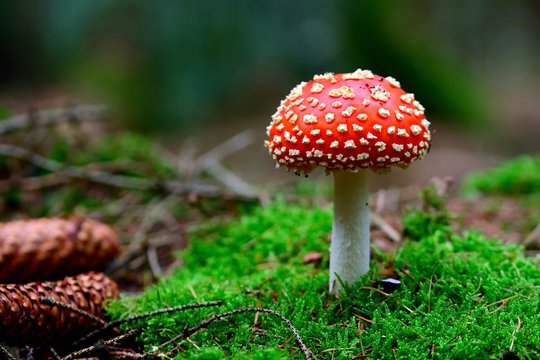Have you ever found a bright red mushroom with white dots in the woods and wondered what it was? If so, you are not alone! Fliegenpilz, also known as Amanita muscaria, has piqued the interest of many due to its beautiful look and rich legend. But what lies beneath its stunning exterior? Join us as we explore the fascinating world of this rare fungus.
What is Fliegenpilz?
Fliegenpilz, also known as Amanita muscaria, is a well-known fungus that grows in a variety of locations worldwide. Its brilliant red crown, covered with white warts, makes it one of the most easily identifiable fungi. Despite its charming appearance, this fungus has a complicated history and fascinating qualities. It lives in coniferous and deciduous forests and flourishes in harmony with trees such as birch and pine. But don’t be misled by its appearance; there’s a lot more to this mushroom than meets the eye.
Mythology and Cultural Significance
For millennia, Amanita muscaria has played an important role in numerous civilizations and mythology. In Siberian shamanic traditions, it was used as a psychedelic substance to provide access to spiritual worlds. The mushroom is prevalent in folklore and art, frequently associated with fairy tales and supernatural creatures. Its eye-catching colors and shape have made it a symbol of whimsy, embodying the beautiful world of nature.
Interestingly, the Fliegenpilz is generally associated with the holiday season, particularly Christmas. The connection between this mushroom and Santa Claus is not purely coincidental. The classic red-and-white colors of Santa’s clothing resemble the brilliant hues of Amanita muscaria, prompting speculation that it impacted current Christmas images. The mushroom’s use in rites and festivals exemplifies how nature and society interact in intriguing ways.
A Closer Look at Chemistry
Not only is Fliegenpilz visually appealing, but it also has a distinct chemical composition. Muscimol and ibotenic acid are among the chemicals found in the mushroom that contribute to its psychedelic effects. While some societies have embraced these traits for recreational or spiritual reasons, use caution. The effects vary considerably amongst individuals, and ingesting the mushroom can result in surprising results.
Interestingly, Amanita muscaria can also be used as a medicinal fungus in some traditional methods. In some cultures, it has been used to cure a variety of diseases, including anxiety and pain treatment. However, it is critical to approach such usage with caution and seek advice from experienced sources before considering any therapeutic use.
Safe Exploration of Amanita Muscaria
Those interested in investigating the world of Fliegenpilz must emphasize safety. While the mushroom’s appearance can be appealing, precise identification is critical because there are dangerous lookalikes in the fungus realm. Enthusiasts should consider joining mycological societies or guided foraging trips, where experienced foragers can offer advice on safe mushroom hunting.
Additionally, if you’re interested in the culinary possibilities of Amanita muscaria, keep in mind that preparation is essential. Cooking can help lessen the mushroom’s hallucinogenic properties, making it safer to consume. However, when seeking to add this unusual fungus into your diet, you must conduct an extensive study and adhere to reliable rules.
The fascination continues
The fascination of Fliegenpilz stems not just from its fascinating beauty, but also from the mysteries it contains. Amanita muscaria continues to fascinate many people, thanks to its rich cultural history and complex chemistry. Whether you’re drawn to its legendary roots, psychotropic powers, or simply its natural beauty, Fliegenpilz provides a glimpse into the mysterious world of mushrooms.
Keep an eye out for this beautiful mushroom when wandering through the woods. Its vivid red top and white dots may just entice you to discover the secrets it holds. The world of Amanita muscaria awaits curious minds to explore, providing a unique blend of wonder and caution—a genuine tribute to nature’s mysticism.
So, the next time you see a Fliegenpilz, take a moment to appreciate the tale behind this amazing mushroom. Who knows what secrets await?
